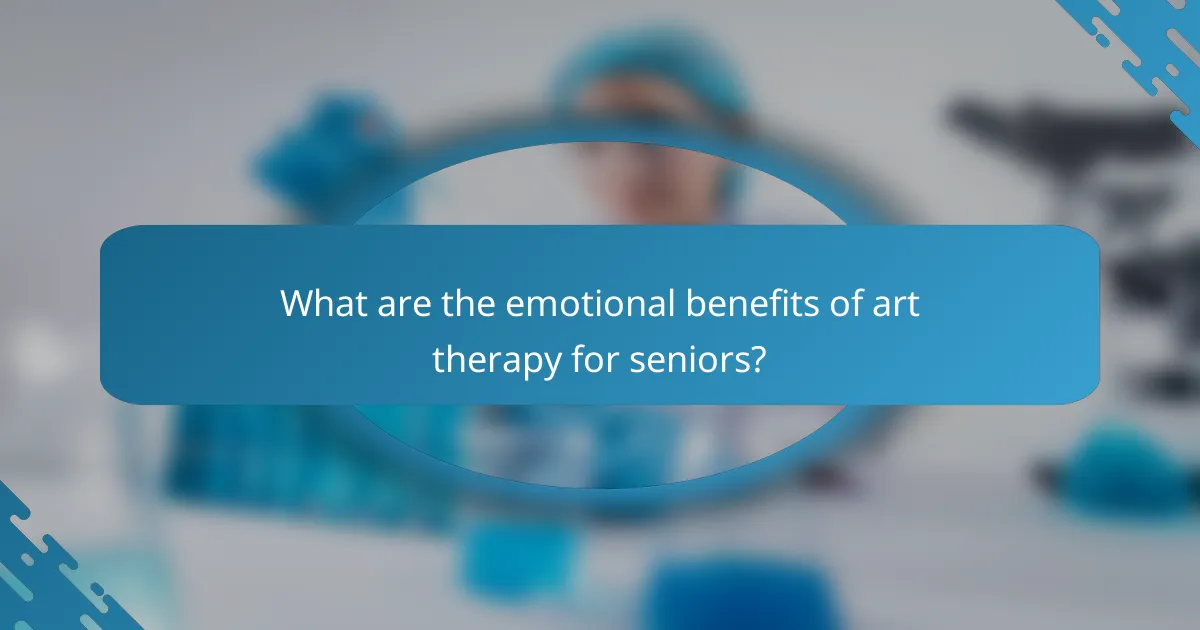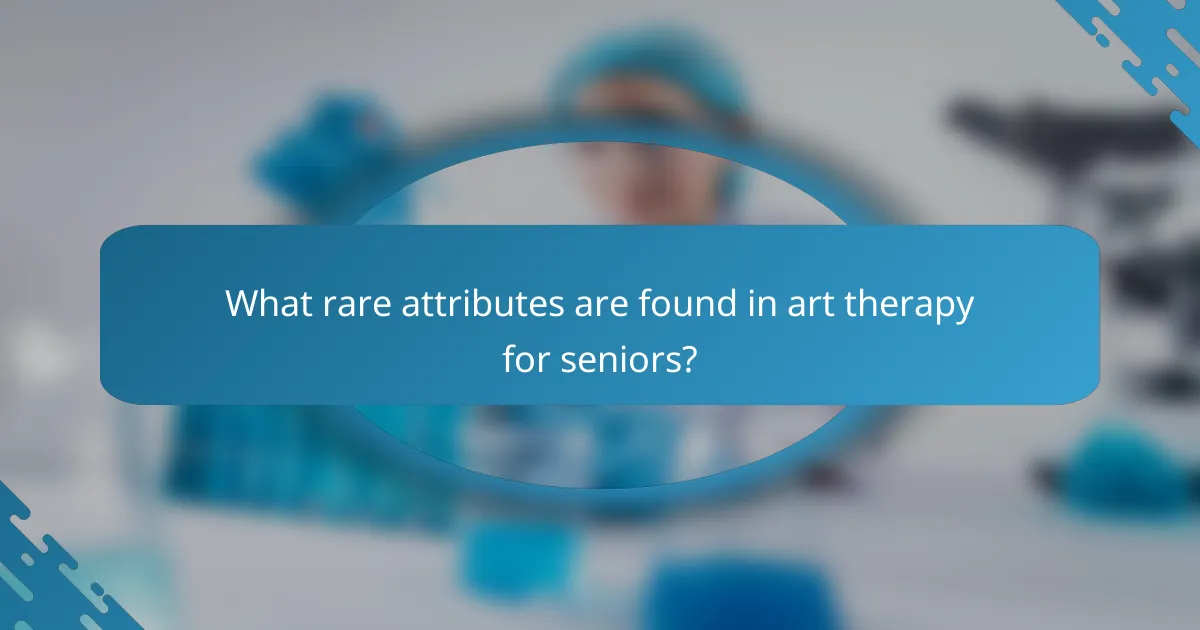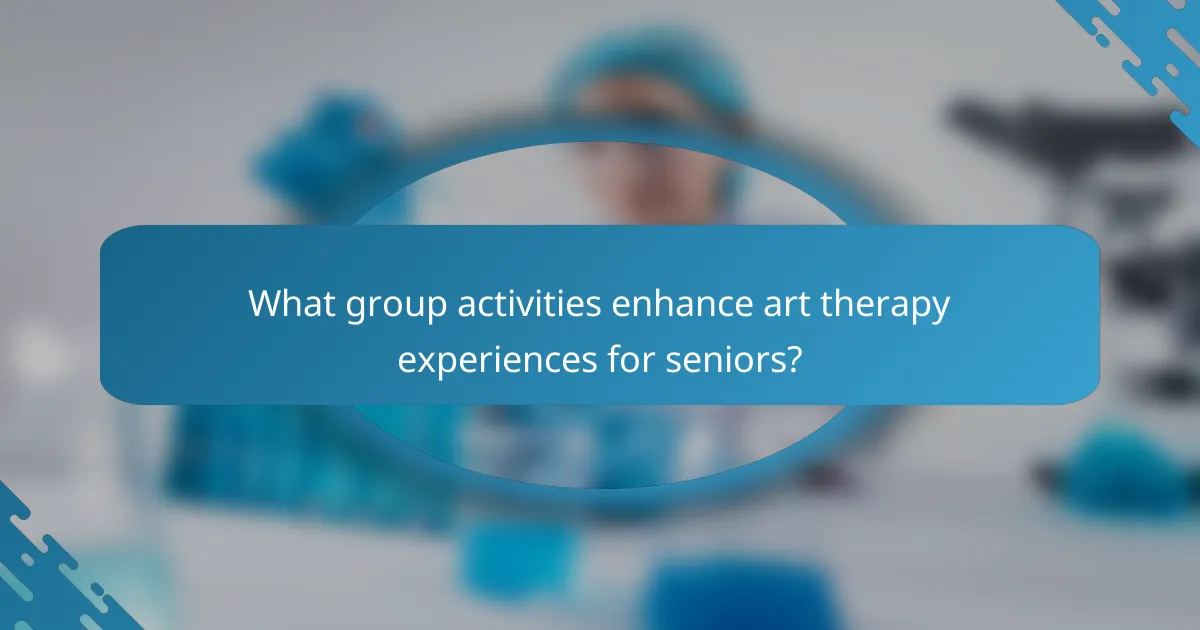Art therapy offers seniors significant emotional benefits, enhancing well-being and reducing feelings of isolation. This article explores effective techniques such as painting and sculpture, highlights the importance of group activities for social connection, and discusses unique attributes that cater to individual mental health needs. Engaging in art therapy can improve mood and cognitive function, making it a valuable resource for seniors.

What are the emotional benefits of art therapy for seniors?
Art therapy provides significant emotional benefits for seniors, enhancing their well-being and quality of life. It fosters self-expression, reduces feelings of isolation, and promotes emotional healing. Engaging in creative activities can lower anxiety and depression, leading to improved mood and cognitive function. Group art therapy sessions also facilitate social connections, helping seniors build supportive relationships and combat loneliness.
How does art therapy improve mental health in older adults?
Art therapy significantly enhances mental health in older adults by fostering emotional expression and reducing feelings of isolation. Engaging in creative activities helps seniors process emotions, improve self-esteem, and develop social connections. Techniques such as painting, drawing, and sculpting provide unique outlets for communication, especially for those with verbal limitations. Group activities promote interaction, creating a supportive environment that encourages sharing and collaboration. As a result, art therapy not only alleviates symptoms of anxiety and depression but also enriches the overall quality of life for older adults.
What role does creativity play in emotional well-being?
Creativity significantly enhances emotional well-being by providing an outlet for self-expression and reducing stress. Engaging in art therapy fosters a sense of accomplishment and improves mood, especially among seniors. Research indicates that creative activities can lower anxiety levels and promote social interaction, which is vital for emotional health. Techniques such as painting, drawing, and crafting not only stimulate cognitive functions but also encourage emotional exploration, helping individuals process feelings and experiences. Group activities further enhance these benefits by building community and connection, essential components of emotional resilience.
How can art therapy reduce feelings of isolation among seniors?
Art therapy can significantly reduce feelings of isolation among seniors by fostering social connections and enhancing emotional expression. Engaging in creative activities allows seniors to share experiences and feelings, promoting a sense of belonging. Group art therapy sessions create a supportive environment where participants can interact, collaborate, and build friendships. This communal aspect is vital, as loneliness often stems from a lack of social interaction. Research shows that art therapy can improve mental well-being and encourage communication among seniors, ultimately leading to reduced isolation.

What techniques are commonly used in art therapy for seniors?
Art therapy for seniors commonly employs various techniques to enhance emotional well-being. These techniques include painting, drawing, collage-making, and sculpture. Each method allows seniors to express feelings, reduce anxiety, and improve cognitive function. Group activities often incorporate collaborative projects, fostering social interaction and community building. Such engagement can enhance the therapeutic experience, providing both emotional support and creative stimulation.
What are the most effective art forms for emotional expression?
Art therapy utilizes various art forms for emotional expression, including painting, drawing, and sculpting. These mediums allow seniors to convey feelings non-verbally, enhancing emotional well-being. Engaging in these activities can reduce anxiety and depression while fostering social connections. Group activities, such as collaborative mural projects, further amplify emotional benefits by promoting teamwork and shared experiences.
How does painting serve as a therapeutic tool?
Painting serves as a therapeutic tool by promoting emotional expression and reducing anxiety. It allows seniors to explore feelings creatively, enhancing their mental well-being. Techniques such as guided imagery and colour therapy facilitate relaxation and joy. Group activities foster social connections, combating loneliness and building community.
What benefits do sculpture and clay modelling provide?
Sculpture and clay modelling offer numerous emotional benefits for seniors. They enhance creativity, reduce stress, and improve fine motor skills. Engaging in these activities fosters social interaction, boosting self-esteem and emotional well-being. Additionally, the tactile experience of working with clay can evoke positive memories, contributing to cognitive stimulation.

What unique attributes distinguish art therapy for seniors?
Art therapy for seniors is distinguished by its focus on enhancing emotional expression and cognitive engagement. Unique attributes include personalised techniques that cater to individual interests, fostering social connections through group activities, and addressing specific mental health needs such as dementia or depression. These tailored approaches create a supportive environment that encourages creativity and self-discovery, promoting overall well-being among seniors.
How does age influence the effectiveness of art therapy?
Age significantly influences the effectiveness of art therapy for seniors. Older adults often benefit from tailored techniques that address their emotional needs and cognitive abilities. Research indicates that art therapy can enhance self-expression and reduce feelings of isolation in seniors, particularly when group activities foster social connections. Additionally, seniors may experience unique emotional benefits, such as improved mood and increased self-esteem, due to their life experiences. The adaptability of art therapy techniques allows for personalised engagement, ensuring that older adults can fully participate and derive value from the sessions.
What specific needs do seniors have that art therapy addresses?
Art therapy addresses seniors’ needs by enhancing emotional well-being, reducing isolation, and improving cognitive function. It provides a creative outlet that fosters self-expression and communication. Techniques such as painting, drawing, and group activities promote social interaction and engagement, addressing loneliness and depression. These benefits are particularly valuable as seniors often face significant life changes, making emotional support crucial.

What rare attributes are found in art therapy for seniors?
Art therapy for seniors can include rare attributes such as enhanced cognitive flexibility, unique personal expression, and improved sensory integration. These traits contribute to emotional well-being and social connection, making art therapy a valuable tool for this demographic. Enhanced cognitive flexibility allows seniors to adapt their thinking, while unique personal expression fosters individuality. Improved sensory integration can lead to better emotional regulation and communication skills.
How can cultural background affect art therapy outcomes?
Cultural background significantly influences art therapy outcomes for seniors. It shapes their expression, preferences, and emotional responses. For instance, seniors from diverse cultures may have unique artistic styles and themes that resonate with their life experiences. This diversity can enhance group dynamics and foster deeper connections among participants. Additionally, understanding cultural nuances allows therapists to tailor techniques, making sessions more relevant and impactful. As a result, culturally sensitive approaches can lead to improved emotional benefits, such as increased self-esteem and reduced anxiety.
What uncommon techniques are used in specialised programs?
Uncommon techniques in art therapy for seniors include expressive movement, digital art creation, and collaborative mural projects. These methods foster emotional expression and social interaction, enhancing overall well-being. Expressive movement combines physical activity with creativity, while digital art allows for accessibility and modern engagement. Collaborative mural projects promote teamwork and community connection, providing a unique therapeutic experience.

What group activities enhance art therapy experiences for seniors?
Group activities that enhance art therapy experiences for seniors include collaborative mural painting, group pottery sessions, and art appreciation discussions. These activities foster social interaction, boost creativity, and improve emotional well-being. Engaging in shared projects encourages communication and strengthens community bonds among participants. Additionally, group art activities can provide a sense of accomplishment and reduce feelings of isolation often experienced by seniors.
How can collaborative projects foster social connections?
Collaborative projects enhance social connections by fostering teamwork and shared experiences. Art therapy for seniors often involves group activities that promote interaction and communication. Participants engage in creative expression, which helps build trust and camaraderie. Research shows that these connections can reduce feelings of isolation and improve emotional well-being. Group art sessions provide a platform for seniors to share stories, encouraging deeper relationships and a sense of community.
What are the benefits of community art exhibitions for seniors?
Community art exhibitions provide seniors with emotional benefits, social engagement, and cognitive stimulation. These events foster a sense of belonging and enhance self-esteem through shared experiences. Participation in art activities can reduce feelings of isolation, promote creativity, and encourage personal expression. Furthermore, art exhibitions often include interactive elements that stimulate mental activity, reinforcing cognitive function in older adults. As a result, these gatherings serve as vital platforms for connection and enrichment in the lives of seniors.

What best practices should be followed in art therapy for seniors?
Art therapy for seniors should prioritise creating a safe and supportive environment. Incorporating techniques like guided imagery and collaborative projects enhances emotional expression. Regular group activities foster social connections, reducing feelings of isolation. Engaging in diverse art forms, such as painting or sculpture, can stimulate cognitive function and creativity.
How can caregivers facilitate effective art therapy sessions?
Caregivers can facilitate effective art therapy sessions by creating a supportive environment and encouraging self-expression. Establish a routine to build comfort, ensuring participants feel safe to explore emotions. Use varied materials to stimulate creativity and adapt activities to individual abilities. Foster group dynamics by promoting collaboration and sharing experiences, enhancing social connections among seniors.
What common mistakes should be avoided in art therapy programs?
Common mistakes in art therapy programs for seniors include inadequate training of facilitators, neglecting individual needs, and failing to create a safe environment. These errors can hinder emotional benefits and overall effectiveness. Proper training ensures facilitators understand therapeutic techniques, while recognising individual needs fosters engagement. A supportive atmosphere encourages expression and connection within group activities.
What expert insights can improve art therapy outcomes for seniors?
Expert insights can significantly enhance art therapy outcomes for seniors by focusing on personalised approaches. Tailoring activities to individual preferences fosters engagement, leading to improved emotional expression. Incorporating familiar themes, such as personal history or favourite colours, can evoke positive memories, enhancing the therapeutic experience. Group dynamics also play a crucial role; fostering a supportive environment encourages social interaction, reducing feelings of isolation. Regular feedback from participants helps adapt techniques, ensuring they remain effective and relevant. These strategies collectively promote emotional well-being and resilience among seniors engaged in art therapy.